Yucatan Farmers
Air Date: Week of December 10, 2010
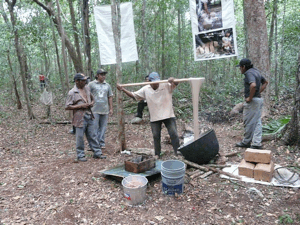 |
While international delegates discuss how to save the world’s forest, host Bruce Gellerman goes straight to the source. Deep in the Yucatan jungle he finds not just trees but an ancient culture struggling to survive.
Transcript
[SOUNDS OF OCEAN]
GELLERMAN: Cancun’s white, powder beach only seems to stretch forever. Earlier this year 15 miles of sand had to be brought in and the beach completely rebuilt after a storm washed Cancun’s sand into the Caribbean Sea. And scientists warn global warning is melting the polar ice caps, threatening low lying places like Cancun.
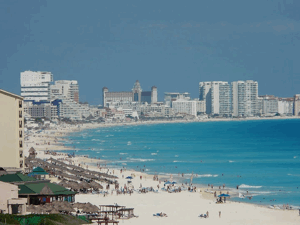
Mexico's high-rise hotels along the Mayan Riviera. No fun in the sun. A hurricane washed the entire 15 mile beach into the Caribbean Sea. It cost $80 million dollars to rebuild. (Photo: Bruce Gellerman)
[MUSIC]
GELLERMAN: The rising tide is in sight, but for most of the four million tourists who come to Cancun each year for sun, sand and fun, climate change is largely out of mind.
TOURIST: It’s my first time here, from the United States. It’s absolutely gorgeous, the water is really, really nice. I’m being treated extremely well. The rooms are really nice. It’s beautiful to be sitting out here. I love it.
GELLERMAN: The United Nations climate summit was held in the sprawling Moon Palace Hotel complex on Cancun’s beach - they call it the Mayan Riviera, but if you’re looking for authentic Mayan culture this place may as well be on the moon.
To see the real thing I traveled with three-van loads of international journalists covering the UN climate negotiations.
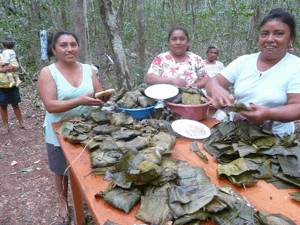
Women on ejido San Antonio Tuk serve lunch for visiting journalists. (Photo: Bruce Gellerman)
[SOUND OF JUNGLE WALKING]
GELLERMAN: It was a five hour journey - and a world away from Cancun - deep into the Yucatan jungle.
All right here we are walking through the forest. It’s a deciduous forest so there are a lot of leaves and underbrush but it’s a very, very dense forest.
The forest is thick with mahogany and cedar, twisted vines, thin scrawny trees and soaring evergreens. Tarzan would feel right at home here - but at a clearing in the woods there’s an unexpected sight.
[SOUND OF CLAPPING]
GELLERMAN: It’s a full blown press event, right here, in the middle of a semi-tropical jungle, in the middle of the Yucatan Peninsula.
[HERNENDEZ SPEAKING SPANISH]
TRANSLATOR: This is Archimedes Hernendez, he’s going to help us with the organization of the event, and he’s going to conduct you to the different parts of this area…
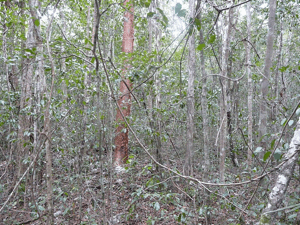
A typical view of the Yucatan Jungle. (Photo: Bruce Gellerman)
[APPLAUSE]
GELLERMAN: Dozen of Mayan forest people have gathered to welcome the visiting reporters. Each of us gets baseball cap with a logo in Mayan, advertising their community agricultural project. Seventy percent of Mexico’s vast forest area is owned by indigenous communities called ejidos or cooperatives.
[SOUND OF JUNGLE WALKING]
GELLERMAN: This ejido, called San Antonio Tuk, has 159 members. They communally own 15 thousand acres-of forest, home to ant eaters, parrots, boa constrictors and jaguar.
Four years ago, the Mexican federal government began paying ejidoistas about 12 dollars an acre a year, to inventory their trees, helping the Maya to get ready for REDD, the UN plan to reduce carbon emissions from deforestation and degradation.
[HERNENDEZ SPEAKING SPANISH]
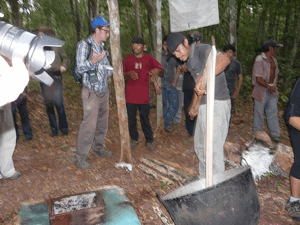
Visting journalist get the story of how natural gum is harvested and processed at ejido San Antonio Tuk. (Bruce Gellerman)
TRANSLATOR: The main objective of San Antonio Tuk with this project is that they want to have more economic support. They are having programs that help them preserve their traditions.
[HERNENDEZ SPEAKING SPANISH]
TRANSLATOR: With this project they also hope to reduce the emissions from deforestation, and degradation.
GELLERMAN: The two goals - preserving the ancient Mayan culture and the forest - is why the members of ejido San Antonio Tuk support REDD. Besides the federal money the community receives for managing the forest in a sustainable way, replanting trees and repairing damaged land, they hope to be able to trade the carbon stored in trees to industrialized countries that want to offset their emissions. It’s economic development designed to lift the Maya from subsistence farming.
[LOPE SPEAKING SPANISH]
GELLERMAN: Eighty year-old year old Catalyna Brezenya Lope remembers what it was like when the community was forced by famine to move to this part of the forest 60 years ago.
[LOPE SPEAKING SPANISH]
TRANSLATOR: She says that when she came here there was nothing, absolutely nothing. They had to build everything, not only a road. And she says the only path they had was the one for the horses carrying the chewing gum. That was it.
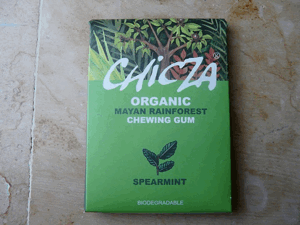
Gum from Ejido San Antonio Tuk (Photo: Bruce Gellerman)
GELLERMAN: You heard right- chewing gum. The natural latex gum found in the chicozapote trees, here on the Yucatan was once the most profitable forest product from these forests. The Mayan call it oro blanco- white gold.
[SOUND OF CHICELERO’S MACHETE]
GELLERMAN: A chiclero harvests the gum from the tree the way its been done for generations. He straps on poyas - spurs on his feet- wraps a thick rope around the tree and himself, and inches up, hacking the bark with his machete just deep enough in a z pattern so the sap flows into a canvas bag on the ground. The thick latex is boiled and shaped into ten kilo bricks.
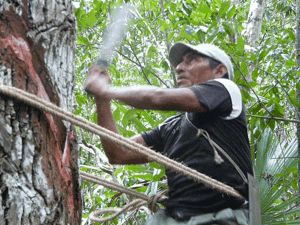
A chiclero hacks at a gum tree to save a forest and a society. (Photo: Bruce Gellerman)
The Maya chicleros used to sell their white gold to U.S. chewing gum companies. But in the 1950’s manufacturers began switching to latex made from petro-chemicals and the value of natural gum and the latex trees sank.
Today, organic chicle is just a fraction of a fraction of the 19 billion dollar a year chewing gum industry. But an association of ejidos is trying to revive the traditional forest product.
[MAN SPEAKING SPANISH]
GELLERMAN: A kilo of organic, natural gum goes for 55 pesos - about five dollars. The ejidos sell it a European manufacturer.
[MAN SPEAKING SPANISH]
GELLERMAN: So how important is this product to your community?
[MAN SPEAKING SPANISH]
TRANSLATOR: The way they extract this gum it represents their traditions and culture, a part of supporting their families.

Boiling the natural latex gum to produce bricks of oro blanco- white gold that will be turned into chewing gum. (Photo: Bruce Gellerman)
GELLERMAN: The chicle trees can be harvested once every three to seven years, after the wounds hacked into the bark heal. But today, there’s a new threat to the Mayan economic and cultural mainstay - climate change.
[MAN SPEAKING SPANISH]
TRANSLATOR: Fifty years ago we were able to extract five kilos of chicle, but nowadays with to global warming we can only extract one kilo and a half.
GELLERMAN: How does the change in temperature effect the tree?
[MAN SPEAKING SPANISH]
TRANSLATOR: This problem is due to the pollution produced by factories, and fires that have been taking place here, and in general by the pollution.
GELLERMAN: The Mayan cooperative culture has the strong social structure and governance needed to prevent illegal logging and insure the money from REDD projects goes to those who own the trees. At San Antonio Tuk violators are banished from the collective. It’s happened just once in the four years the ejido has been getting money from the Mexican government to prepare for REDD.
What needs to be improved to make this project even better?
[MAN SPEAKING SPANISH]
TRANSLATOR: They want more support from other people, organizations…
GELLERMAN: Government? NGOs?
TRANSLATOR: Particular people, everyone.
GELLERMAN: What happens if this program doesn’t exist - what happens to your people?
[MAN SPEAKING SPANISH]
TRANSLATOR: The forest can disappear. The forest can disappear.
Living on Earth wants to hear from you!
Living on Earth
62 Calef Highway, Suite 212
Lee, NH 03861
Telephone: 617-287-4121
E-mail: comments@loe.org
Newsletter [Click here]
Donate to Living on Earth!
Living on Earth is an independent media program and relies entirely on contributions from listeners and institutions supporting public service. Please donate now to preserve an independent environmental voice.
NewsletterLiving on Earth offers a weekly delivery of the show's rundown to your mailbox. Sign up for our newsletter today!
 Sailors For The Sea: Be the change you want to sea.
Sailors For The Sea: Be the change you want to sea.
 The Grantham Foundation for the Protection of the Environment: Committed to protecting and improving the health of the global environment.
The Grantham Foundation for the Protection of the Environment: Committed to protecting and improving the health of the global environment.
 Contribute to Living on Earth and receive, as our gift to you, an archival print of one of Mark Seth Lender's extraordinary wildlife photographs. Follow the link to see Mark's current collection of photographs.
Contribute to Living on Earth and receive, as our gift to you, an archival print of one of Mark Seth Lender's extraordinary wildlife photographs. Follow the link to see Mark's current collection of photographs.
 Buy a signed copy of Mark Seth Lender's book Smeagull the Seagull & support Living on Earth
Buy a signed copy of Mark Seth Lender's book Smeagull the Seagull & support Living on Earth

